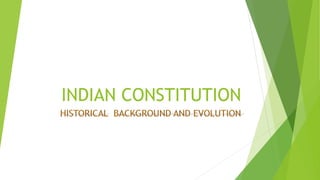INDIAN CONSTITUTION evolution and history .pdf
- 6. * The system of election introduced by the Act provided for separate representation for Muslim Community. * Only Muslims should vote for candidates for Muslim seats (separate electorates)
- 7. Ō¢¬ The Secretary of State for India was empowered to increase the number of the Executive Councils of Madras and Bombay from two to four. Ō¢¬ Two Indians were nominated to the Council of the Secretary of State for Indian Affairs.
- 8. Ō×óThe number of the members of the Legislative Council at the center was increased from 16 to 60 The members of the Legislative Councils were permitted to discuss the budgets, suggest the amendments and even to vote on them; excluding those items that were included as non-vote items. They were also entitled to ask supplementary questions during the legislative proceedings.
- 11. It separates the subjects of administration into two categories: Central and Provincial. The subjects which were brought under the category ŌĆśCentralŌĆÖ were subjects of all India importance. The matters relating to the administration of ŌĆśprovincesŌĆÖ were classified as ŌĆśprovincialŌĆÖ. This was actually a relation of control over provinces, even in legislative and financial matters.
- 12. ŌĆó The idea of a Constituent Assembly to frame the Constitution of India was first mooted by the Communist leader MN Roy.
- 13. ŌØæ The Indian National Congress (INC) demanded a Constituent Assembly for the first time in 1935.
- 14. The British Government accepted the demand in its ŌĆ£August OfferŌĆØ in 1940.
- 15. ŌĆó In 1940, the coalition government in Britain recognized this demand. ŌĆó In 1942, they sent Sir Stafford Cripps to India with a draft declaration of proposals (Cripps proposals). ŌĆó But parties including Muslim league didnŌĆÖt accept it
- 17. THE CONSTITUENT ASSEMBLY OF INDIA: ŌĆó The first meeting of the Constituent Assembly was convened on December 9, 1946 with Sachchidanand Sinha as the Interim President. He was the oldest member of the assembly.
- 18. On December 11 , 1946, Dr Rajendra Prasad was elected as Permanent President of the Constitution Assembly. The Muslim League boycotted the meeting and insisted on a separate state of Pakistan.
- 19. ŌØ¢ Members of the constituent assembly were chosen by indirect election by the members of the Provincial LegislativeAssemblies. ŌØ¢ The total membership of the Assembly was 389. The arrangement was (i) 292 members were elected through the Provincial Legislative Assemblies; (ii) 93 members represented the Indian Princely States; (iii) 4 members represented the Chief Commissioners Provinces. After the partition the membership of the Assembly was reduced to 299
- 20. OnDecember 13, 1946, Jawaharlal Nehru moved the historic ŌĆśObjectives ResolutionŌĆÖ in the Assembly. It pledged to make India an independent sovereign union of states. The Resolution was unanimously adopted by the Constituent Assembly on 22 January 1947.
- 21. The Constituent Assembly took 2 years, 11 months and 18 days to frame the Constitution. Originally, the Constitution had 22 parts, 395 articles and 8 schedules. Presently, it consists of 450 articles (divided into 24 parts) and 12 schedules. ŌØæ The Constitution of India was adopted on 26 November, 1949 The Constitution of India came into force on 26 January, 1950. On that day, the Assembly ceased to exist, transforming itself into the Provisional Parliament of India until a new Parliament was constituted in 1952.
- 22. ŌĆó Government of India Act of 1935 ŌĆō Federal Scheme, Office of Governor, Judiciary, Public Service Commission, Emergency provisions and administrative details. ŌĆó British Constitution ŌĆō Parliamentary System, Rule of law, Lagislative Procedure, Single Citizenship, Cabinet System, Prerogative Writs, Parliamentary Privileges and Bicameralism.
- 23. Irish ConstitutionŌĆō Directive Principles of State Policy, nomination of members of Rajya Sabha and method of election of president Canadian ConstitutionŌĆō Federation with a strong Centre, vesting of residuary power in the centre, appointment of state Governor by the centre and advisory jurisdiction of Supreme Court. Australian ConstitutionŌĆō Concurrent list, joint sitting of two houses of Parliament. Constitution of GermanyŌĆō Suspension of fundamental rights during emergency. French ConstitutionŌĆō Republic and ideals of liberty, equality and fraternity in the Preamble. South African Constitution- Procedure for amendment of the constitution and election of members of Rajya Sabha.























